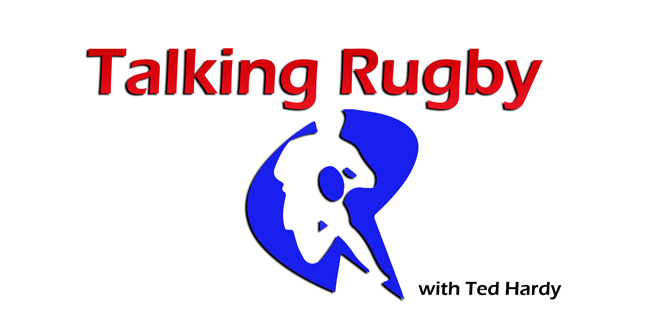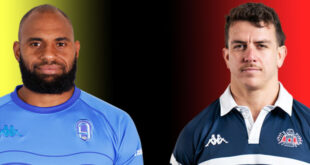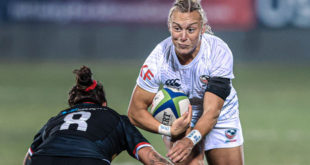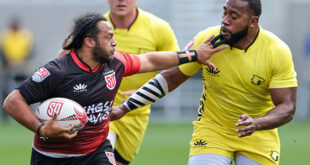This weekend PRO Rugby North America hit the midway point in their inaugural season. Can it be? Already? After years of waiting, it doesn’t seem possible that we’re already looking at the business end of the first season of professional rugby in the USA. The midway point gives us an excellent chance to take a look at what has happened thus far and peek into the crystal ball to see what the 2nd half of the season and the future may hold.
The Launch
Given the relative shoe-string budget the competition is working with, we all knew there would be bumps in the road and indeed there were. Please note that even on a limited budget, the amount of money being invested in PRO is significant. Professional sport is not cheap, even at entry levels.
The competition launch went off successfully with decent crowds, fan fervor, and local media interest. Early on, there were concerns regarding the broadcast/streaming of the competition. AOL seemed like and odd partner from the very start and that proved to be true as within weeks of the competition launching, PRO had switched to streaming matches through YouTube which is where they should have started.
Then there was the breakup between PRO and Infinity Park. A relationship that was probably doomed from the very start. Denver was the last team announced for a reason. Negotiations between the two groups had drug on far longer than anyone expected. Both groups have their reasons for the split, so pointing fingers would be useless at this juncture.
Again, these are lessons that are being learned on the fly. The fluidity of the competition has allowed PRO to make changes within the playing season. These are moves that would be impossible in a more mature professional competition. The important part is that adjustments were made for the better. PRO came out on both ends in a better situation. We now have easy access to watch games live and on replay and all matches for the remainder of the season are going to be streamed. Both good things for fans and the competition.
The big concern was the lack of info coming from PRO on both moves. There is little doubt that both moves were good for the competition, so it was difficult to understand why they weren’t advertised better. Information dissemination is still a growth area for the fledgling competition.
The crowds have been decent in the early goings, averaging between 1500-3000 per match. The big question being where is the break-even point in regards to attendance? I’m guessing they’d prefer something closer to the 3000-4000 range so they may be in the ballpark.
On the pitch, the action has been exciting, but inconsistent. The switch from amateur to professional is still very much a work in progress for many of the players. Adjustments from the first few weeks of the season to the mid-point have been noticeable. Fitness is slowly, but surely improving as is structure. Handling errors seem to be the area that plagues most of the teams. That said, most of the players involved have never consistently faced the level of competition that they have seen in PRO.
As the season continues, fans are seeing the impact of the seasoned professionals more and more. There are some excellent veteran players in PRO Rugby and I hope that fans are enjoying and appreciating their presence. This first group of players is laying the groundwork for more like them to give the USA a look in the future. By all signs, it appears as if more are interested.
Mid-season Team Reports
Right now it looks like it has turned into a two-team race with Denver and San Diego atop the pack. Ohio has a chance of making a move, while San Francisco and Sacramento pull up the back of the pack.
Denver remains undefeated going into the second half of the season and has done so with a clinical approach, a set of forwards that can take over a match, and backs that get the job done. They aren’t a flashy group, but have the most consistent mix of players in the entire competition.
San Diego sits in second place with a 4-1 record, with their only loss coming to Denver 22-16. They have an explosive backline and an improving pack of forwards. Before the season is over, they’ll have something to say about who ends up as the 1st PRO Champion.
Ohio has been the most maddening team in the league. They’ve played beautiful rugby at times and then killed themselves with mistakes and inconsistency. They should have beaten Denver on the road in Week 1 and lost on the road to San Diego on the last play of the game. Then they follow by losing to previously winless San Francisco. They may still be a dark horse for a 2nd half surge, but need to work out their inconsistency.
San Francisco finally got their first PRO win and has to be a huge relief to the squad. Another squad with an explosive backline, San Francisco has been hampered by their forwards whom have underperformed. They put up a strong performance against Ohio, so may have turned a corner. They still have some weaknesses, so a push towards a title isn’t likely, but they certainly have a chance to pick up a couple more wins.
With the San Francisco win last weekend, Sacramento drops into last place at the midway point. After an opening weekend come from behind win over San Francisco, Sacramento has dropped five straight matches. They’ve got talented players, but have struggled to stay in games late in the match.
The Future
Everything coming out of the PRO camp indicates that they’re aiming to expand in 2017. We’ve heard somewhere between 3-5 teams could be added in 2017. This is a notion that should excite fans in Canada and the Eastern portion of the USA. With a Western heavy initial group, it is likely that the east should get some professional teams in 2017. The same can be said of Canada, whom have sent a number of players to play on US-based teams this season. Expect there to be at least one Canadian team in PRO Rugby in 2017. If the competition does add five teams, then there could be two.
There’s no sense getting into the debate over which cities will get teams as well all know how that went last time around. As with this year, the locations will be venue driven. As we’ve seen in Ohio, PRO is more than willing to build something out of nothing so it is really hard to rule out any region. Existing facilities are preferred, but the turf regulations set down by World Rugby is the reason we ended up with four Western teams this season. Fans can expect more of the same when the new teams are announced. Appropriately sized and approved venues remain a stumbling block.
While everyone is excited to see more teams east of the Mississippi, the crux in expanding the competition is the quality of play. What we’ve seen so far is a decent start, but far from high level professional rugby. The expectation moving forward is that play will improve. PRO Rugby has set a baseline and need to make sure that the quality of play on the pitch improves from here on out. This is a must in order to add fans and begin to draw in sponsors and broadcasting revenue. Adding five new teams will further stress an already depleted player pool. More overseas players are expected, but the bulk of the players still need to come from domestic clubs (what that may do to club rugby is another story entirely). Help from Canada will be a must as well.
These are all questions soon to be asked of PRO Rugby. We’ve got professional rugby. Now, we can figure out how to make it better and grow the fan base.
In the meantime, let’s all enjoy the 2nd half of the season, and relish in the fact that we can even have these conversations.
 Americas Rugby News Rugby news from across the Americas!
Americas Rugby News Rugby news from across the Americas!




